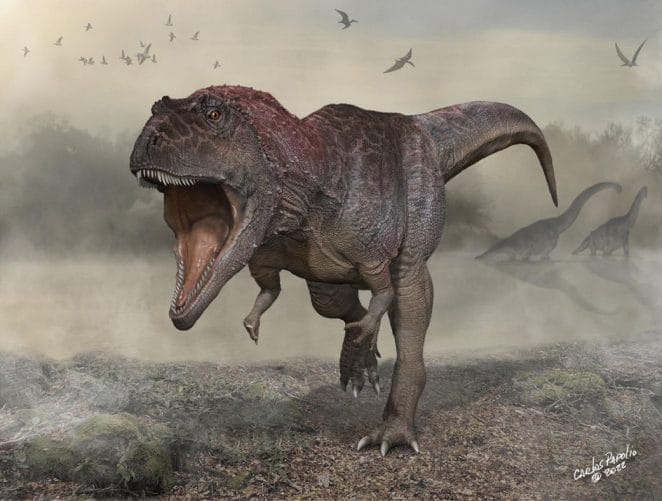A huge theropod skeleton was discovered in an approximately 94-million-year-old rock stratum of Argentina’s Huincul Formation in 2012. A team of experts began excavating the remains in 2014. Juan I Canale, Sebastián Apestegua, Pablo A. Gallina, Jonathan Mitchell, Nathan D. Smith, Thomas M. Cullen, Akiko Shinya, Alejandro Haluza, Federico A. Gianechini, and Peter J. Makovicky described the type species Meraxes gigas in 2022.

The fossil is made up of an incomplete skeleton and skull components. The dinosaur was roughly 50 years old when it died, which is very elderly for a primitive theropod. Meraxes’ skull had crests, furrows, lumps, and little horns, according to scientists. The meraxes’ body is eerily similar to that of tyrannosaurs. The skeleton is one of the most complete carcharodontosaur skeletons discovered in the southern hemisphere, according to palaeontologists.
1: Meraxes quick facts:
Name: Meraxes (Greek for “Giant Dragon”); pronounced mər-ahk-seez
When it lived: Late Cretaceous, 95 to 93.9 million years ago
Type of dinosaur: Large Theropod
Location: Argentina
Habitat: Terrestrial.
Length/Weight: 11 meters/4263kg
Diet: Carnivorous
Distinguishing Characteristics: Short arms and a huge skull.
Named by: Juan I. Canale (2022)
2: How do you pronounce ‘Meraxes’?
The name Meraxes should be pronounced “mər-ahk-seez.”
3: What does the name Meraxes mean?
The generic name is a reference to a dragon in the fantasy novel A Song of Ice and Fire. In Latin, the particular epithet means “giant.” The 94-million-year-old dinosaur was named after a dragon from the literary legend that inspired the hit TV show “Game of Thrones.”
4: What Did Meraxes Look Like?
Meraxes was a member of the theropod family Carcharodontosauridae, which also included other titanic dinosaurs such as Giganotosaurus, Mapusaurus, and Carcharodontosaurus. Researchers estimate that Meraxes gigas measured 11 metres in length and weighed approximately 4 tonnes.

The species featured a skull ornamented with crests, bumps, and small horns, and the individual that was unearthed looks to have perished at approximately 50 years of age, which is roughly double the average lifespan of Tyrannosaurus rex. M. gigas roamed the Earth during the Late Cretaceous Epoch, around 20 million years before T. rex, and the dinosaurs are quite distantly related on the evolutionary tree.
Sources:Wikipedia





GIPHY App Key not set. Please check settings